Michigan Museday Matches Nickels and Dimes

Background image by mgouser hillhaus
A thing I noticed this offseason while going over the depth and usage of various Michigan defenders is that Mattison used a lot more nickel than we gave him credit for. One thing Ace noted was that we're (finally) recruiting more cornerbacks. We shrugged a bit while losing two more CBs to playing time transferitis this fall, but I don't think we should be shrugging so much.
A little background (skip this if you already know personnel terminology and usage): Defensive coaches tend to match their personnel to the types of players on the field for the offense, NOT the formation. In general the number of backs and tight ends will be matched by linebackers, and the more that come out for receivers the more DBs the defense will send out. Three wide receivers generally means five defensive backs (i.e. nickel), two wide receivers equals four DBs (e.g. 4-3 or 3-4), etc.
The classic personnel shift is on 3rd and long, when the steady rock-pounders make way for the seven-yards-or-bust fellas. But it happens so often despite the situation that it's more accurate to see the game of matching personnel as another strategic aspect of the master's football game.
The offensive personnel is usually expressed in three digits meaning # of RBs, # of tight ends, and # of receivers, respectively. So 113 means 1 RB, 1 TE, and three WRs. Sometimes they'll call that same "eleven" personnel, referring to the first two digits. Examples below; click embiggerates.
Not different:
Different:
How the matching up occurs is up to the coach. You could, for example, play a run-first OLB whenever a fullback is in, and sub him for a more rangy linebacker when the the fullback runs off the field for a tight end who's a known receiving threat. This happens all the time, but it's hard to track the defenses' reactions since we can't tell one linebacker in a formation from another in UFR. We do have data from which we can determine how many receivers were out there at any given time, and it's clear from these data that the more receivers the more defensive backs.
From the UFR defensive database, Michigan in 2011 was no exception: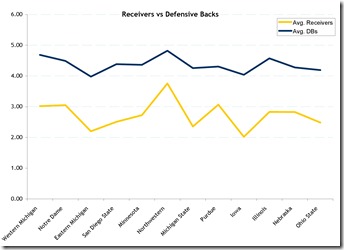
| Avg. Personnel | |||
|---|---|---|---|
| WRs in Game | DL | LBs | DBs |
| Four | 3.8 | 2.4 | 4.7 |
| Three | 3.8 | 2.5 | 4.7 |
| Two | 4.0 | 3.0 | 4.0 |
| One | 4.1 | 3.3 | 3.6 |
| None | 4.7 | 3.3 | 3.0 |
| Average | 3.9 | 2.7 | 4.4 |
The last row is important because it shows Michigan left its base 4-3 Under set for an extra defensive back far more often than otherwise, usually at the expense of a linebacker. We didn't go to a nickel every time three receivers stepped on the field, in fact there were 22 plays charted where Mattison put his 4-3 personnel against four-wide (mostly against Northwestern and Purdue). But the charts not only say that Michigan was forced out of its base 4-3 set often; it says we played more Nickel downs than 4-3.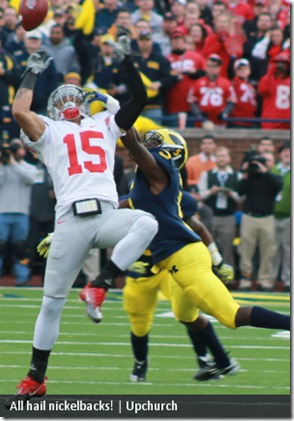
| Receivers in Formation | ||||||
|---|---|---|---|---|---|---|
| Def. Form | 4 | 3 | 2 | 1 | 0 | Total |
| Nickel | 121 | 155 | 14 | 1 | x | 291 |
| 4-3 | 22 | 34 | 195 | 29 | x | 280 |
| Okie | 20 | 32 | 2 | x | x | 54 |
| 4-4 | 1 | x | 6 | 11 | 1 | 19 |
| 4-6 | x | x | 10 | 5 | x | 15 |
| 3-3-5 | 5 | 7 | 1 | x | x | 13 |
| 5-3 | x | x | 1 | 2 | 1 | 4 |
| Goal line | x | 1 | x | 2 | 1 | 4 |
| 3-4 | 1 | 1 | x | 1 | x | 3 |
| 6-2 | x | x | 1 | 1 | x | 2 |
| Dime-30 | 1 | x | x | x | x | 1 |
| Dime-40 | x | 1 | x | x | x | 1 |
| Total | 171 | 231 | 230 | 52 | 3 | 687 |
If I remove 4th quarters and all plays that occurred when Michigan was up by more than one score, the 4-3 just barely edges the Nickel, 147 to 140. This isn't opponents trying to play catch-up. It's two things: the personnel that Mattison inherited, and the spread offense forcing Michigan to adapt to it.
--------------------------------------------
Why all the nickel and diming? The first part is a story about outside linebacker. Early in the 2011 season Michigan played Brandon Herron and Brandin Hawthorne at WILL, while at SAM we lost Cam Gordon to injury and his backup was a redshirt freshman. That freshman, Jake Ryan, was earning his way toward more playing time, but in the meantime we still had Carvin Johnson taking snaps at free safety while Thomas Gordon was in at the nickel role. Watch what happened at about mid-season:
That is Gordon moving to free safety and splitting time with Woolfolk, while the freshmen linebackers had their usages increase. Greater faith in Jake and Des explains some of the variance, however the real story is matching personnel:
| Opponent | Receivers | DBs | Difference | 4-3 | Nickel | Okie | Other |
|---|---|---|---|---|---|---|---|
| Western Michigan | 3.02 | 4.68 | 1.67 | 15.79% | 59.65% | 15.79% | 8.77% |
| Notre Dame | 3.05 | 4.49 | 1.44 | 25.00% | 51.25% | 12.50% | 11.25% |
| Eastern Michigan | 2.20 | 3.98 | 1.78 | 57.78% | 17.78% | 4.44% | 20.00% |
| San Diego State | 2.51 | 4.38 | 1.88 | 43.21% | 44.44% | 6.17% | 6.17% |
| Minnesota | 2.72 | 4.36 | 1.64 | 50.00% | 41.67% | 2.78% | 5.56% |
| Northwestern | 3.75 | 4.82 | 1.07 | 14.75% | 80.33% | 0.00% | 4.92% |
| Michigan State | 2.36 | 4.25 | 1.90 | 55.93% | 32.20% | 1.69% | 10.17% |
| Purdue | 3.07 | 4.30 | 1.24 | 60.87% | 32.61% | 0.00% | 6.52% |
| Iowa | 2.02 | 4.04 | 2.02 | 64.81% | 16.67% | 5.56% | 12.96% |
| Illinois | 2.83 | 4.57 | 1.74 | 25.71% | 52.86% | 14.29% | 7.14% |
| Nebraska | 2.83 | 4.28 | 1.45 | 37.50% | 35.00% | 15.00% | 12.50% |
| Ohio State | 2.48 | 4.19 | 1.71 | 58.62% | 24.14% | 12.07% | 5.17% |
| Total | 2.75 | 4.38 | 1.63 | 40.76% | 42.36% | 7.86% | 9.02% |
I pointed out the two extremes on the schedule with boldation: Northwestern used about twice as many receivers in their formations as Iowa did, but there was a limit to how many defensive backs Michigan would counter with. The nickel served as well for 4 WR as for 3, yet accounted for 4 in 5 plays. However when the opposition went to 2 WR (Iowa), Mattison could spend a majority of the game in the 4-3.
--------------------------------------------
When Michigan's on offense. Nothing is out of the ordinary yet, but when we turn the tables and show how defenses have reacted to Michigan's personnel it gets interesting:
| Season | Avg. Receivers in Formation | Avg. DBs in Formation | Difference |
|---|---|---|---|
| 2008 | 3.13 | 4.36 | 1.2 |
| 2009 | 2.84 | 4.46 | 1.6 |
| 2010 | 3.07 | 3.93 | 0.9 |
| 2011 | 2.62 | 4.2 | 1.6 |
| Total | 2.91 | 4.22 | 1.3 |
This is not including anything when Michigan was more than a score down, but the season averages counting everything say about the same thing. I went through the plays and even a few youtubes and yes, in 2010 they played one-high against us despite spreading the field to pass as much as Purdue. Michigan went bigger in 2011, and got more defensive backs, which is counterintuitive except for one factor: opponents in 2010 really really really feared the running game, and tempted Michigan to pass.
Okie dokie. | Greg Shamus via ESPN
One more table to break this down by Michigan's opponents last year, 4th quarters and two-plus-score leads excised:
| Opponent | WRs in formation | DBs in formation | Difference |
|---|---|---|---|
| Western Michigan | 2.41 | 3.97 | 1.6 |
| Notre Dame | 3.10 | 4.60 | 1.5 |
| Eastern Michigan | 2.71 | 4.11 | 1.4 |
| San Diego State | 2.44 | 4.89 | 2.4 |
| Minnesota | 2.31 | 3.77 | 1.5 |
| Northwestern | 2.55 | 3.89 | 1.3 |
| Michigan State | 2.54 | 4.00 | 1.5 |
| Purdue | 2.53 | 4.13 | 1.6 |
| Iowa | 2.67 | 4.08 | 1.4 |
| Illinois | 2.78 | 4.04 | 1.3 |
| Nebraska | 2.67 | 4.43 | 1.8 |
| Ohio State | 2.79 | 4.21 | 1.4 |
| Total | 2.62 | 4.12 | 1.5 |
Nothing really jumps out except perhaps more spread in close games, and SD State's apparent paucity of linebackers (weird—didn't they just have that guy who recruits lots of linebackers there?) Actually that's Charlie Strong's 3-3-5, and the GERG numbers from 2010 are similar due to the same effect.
--------------------------------------------
What it means for this year. Alabama and Air Force aren't going to be spread it out—their challenges are elsewhere. However the Big Ten schedule is spread-heavy, with Ohio State joining the ranks of the many-receivered. Due to recent attrition, Michigan goes into 2012 with just six scholarship cornerbacks for three positions that will be filled half the time. It's a good thing the coaching staff has four guys coming in at corner to replace the one expected departure. These days, in order to keep up with the Joneses, that nickelback position has to be considered as much of a starter as, well, a third receiver.

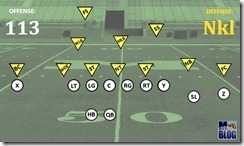
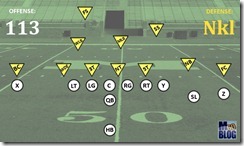
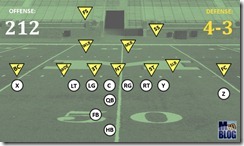
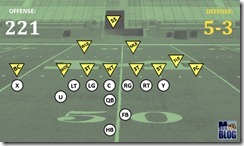
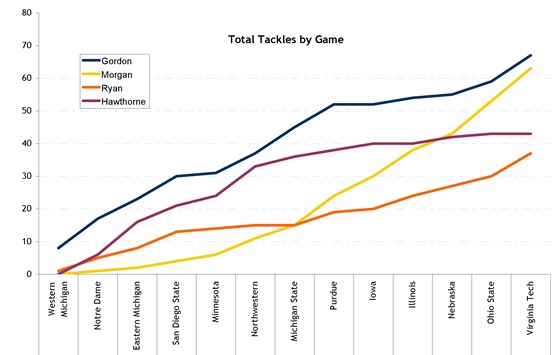

Comments